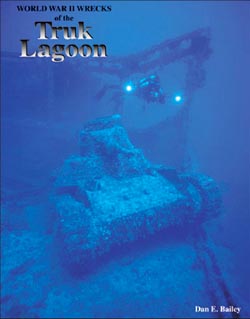|
|
|
|
| Missing In Action (MIA) | Prisoners Of War (POW) | Unexploded Ordnance (UXO) |
| Chronology | Locations | Aircraft | Ships | Submit Info | How You Can Help | Donate |
|
 by Dan E. Bailey North Valley Diver 2001 Hardcover 518 pages Index, photos, maps, appendix ISBN: 0-911615-06-7 $70.00 plus shipping Order now at amazon.com Features Return to |
World War II Wrecks of the Truk Lagoon Dan Bailey first visited Truk Lagoon in 1971. Since then, he has returned over forty times in the past thirty years. The release of the beautiful hardcover edition of WWII Wrecks of the Truk Lagoon is a volume that anyone interested in Truk should acquire and add their book collection. This book builds off the previous 1989 version. With new research, discoveries and photography this book is an entirely new and expanded volume over 500 pages long! As you will see below, this book goes highly recommend, and is a benchmark for all history and photograph books in the genera of Pacific diving and history. The first thing noted, is the production value of the book. It is certainly worth its weight - as it is a full size book, with hundreds of B&W wartime photos, line drawings, schematics and lavish color photographs taken underwater. Also, the author presents these photos in very large format 5 x 7 or larger. This is a treat for readers, who appreciate the crisp details of each image. The text is well laid out, and easy tread in two column format. The cover of the book is a full sized image of deck of the San Francisco Maru, and the Type 95 Ha Go Light Tanks stowed on the deck. Aficionados of the Pacific Wreck Database website will appreciate that the diver behind the tank is contributor Peter Ording. This tank is the same pictured on National Geographic Magazine May 1976, that for many world wide sparked widespread interest in Truk Lagoon (myself included). In my opinion, Bailey's cover photo a far better photograph of this eerie scene. Truk Today Background Island Installations
Allied Air Campaign Against Truk Lt. (jg) H.R. Hudson Following a strafing run of the Param Airfield, Lt. Hudson came upon a Kate very low off the water (about 15 feet). He mad an astern run and obtained hits throughout the fuselage area. The Kate burned and crashed. The level of history puts the reader in the cockpit of each airplane, and give one the sensation of the enormous operation, and how many planes participated, and how much damage was caused with bombs and bullets. WWII strike photographs that are breath taking accompany the accounts were appropriate. Hailstone was the most famous event at Truk, but what is really exciting about the history section is that it includes far more that just this one mission. Equally intriguing and detailed are the coverage of the Japanese Strikes carried out in retaliation after the raid. Also, land based strikes by the U.S. Army Air Force (USAAF) 13th Air Force, Fast Carrier Strikes in late April, 1944 and in October 1944 to August 1945 experimental B-29 Superfortress raids and even an attack by Royal Navy carrier aircraft during "Operation Inmate" The history section ends with details of the Japanese surrender on September 2, 1945 when the remaining 24,061 Naval personnel and 14, 299 Army troops laid down arms. Following surrender, the American occupation that began on November 24, 1945 and efforts to repatriate the military personnel, clean up the island dispose of munitions and assist with the cleanup. The investigations and trials of war crimes committed against captured Allied aviators and other prisoners for torture, medical experiments The last Japanese military left on December 26, 1946. Wrecks of the Truk Lagoon This intensity of research is repeated for more than
fifty Truk shipwrecks, and half dozen submerged aircraft. Reading about
each of the Japanese wrecks widens the readers appreciation for the
enormous amount of history and human interest stories about the Japanese
side of the history and that each of these vessels contain, and the
details of how they met their final demise in the Lagoon of Truk. The book has many audiences, firstly any veterans of the Operation Hailstone February 1944 air strikes. Also, anyone interested in Pacific War, World War II history and the military archeology of the Truk. And, of course any SCUBA divers will appreciate Bailey's detailed dive notes for those who intend to dive Truk Lagoon themselves. Interview with author Dan E. Bailey Review by Justin Taylan Return to Book Reviews | Add a review or submit for review |
| Discussion Forum | Daily Updates | Reviews | Museums | Interviews & Oral Histories |
|